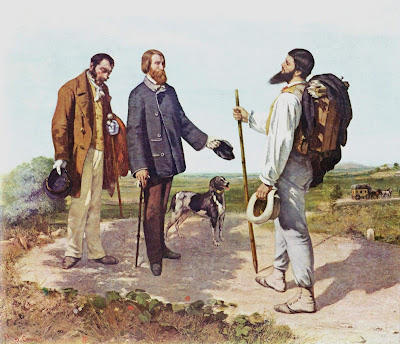 |
La Rencontre (Bonjour, Monsieur Courbet) Gustaves Courbet, 1854 Oil on canvas, s129 x 149 cm Musée Fabre, Montpellier, France |
If you've done any reading on plein air painting history, no doubt you've come across “The Meeting: Bonjour, Monsieur Courbet.” This iconic painting by Gustave Courbet (1819-1877) shows the artist, geared up for an outing with an easel strapped to his back, as he encounters one of his patrons in the field. I've always admired the jauntiness of Courbet's beard and find it the most intriguing part of the picture.
Courbet was one of the first French painters to break away from the Romantic tradition and to embrace Realism. But he didn't care for the label. He wrote, “The title of 'Realist' was thrust upon me just as the title of 'Romantic' was imposed upon the men of 1830. Titles have never given a true idea of things: if it were otherwise, the works would be unnecessary.”
Even so, that was his approach—to study the world and paint it as he saw it: “To know in order to do, that was my idea. To be in a position to translate the customs, the ideas, the appearance of my time, according to my own estimation; to be not only a painter, but a man as well; in short, to create living art—this is my goal.”
Although he first began as a painter of large-scale literary scenes, he soon moved to painting works featuring less-accepted subjects such as peasants and laborers. Then, on trips to the Low Countries, he discovered an artistic kinship with painters of the quotidian, such as Franz Hals, which convinced him that painting ordinary subjects was the way to go. He also began to politicize his canvases by addressing social issues.
During the mid-1860s, Courbet spent time painting en plein air along the Normandy coast with Eugène Louis Boudin, one of the foremost painters of marine landscapes. Over time, he developed a technique of using a palette knife to put down thick layers of paint and to create a texture that emulated the textures he saw in the landscape before him. He was often ridiculed in the critical press for the thick impasto.
Courbet's painterly relationship with the everyday extended into his personal life—he was a committed socialist—and he became involved with the short-lived Paris Commune. Once the Commune was overthrown, he was arrested and sent to prison for six months. (He was allowed paints and an easel and painted a series of still lifes.) Upon his release, the government ordered him to pay a bill for 323,091 francs and 68 centimes to cover the reconstruction costs of the famous Napoleonic Column, which he helped pull down during the Communard takeover. Sadly, unable to pay, Courbet fled France for Switzerland, where he lived out his remaining few years, painting tourist landscapes before dying of alcoholism at age 58.
What does Courbet's beard signify in his painting? Here we have Alfred Bruyas, the man in the fine suit and with gloves in hand, the son of a wealthy banker. And here we have Courbet, garbed in clothes appropriate for the field, the outspoken socialist and supporter of the Common Man. Whereas Bruyas greets Courbet in a manner of a man humbled before his better—Bruyas was a sometimes-painter as well as one of Courbet's patrons—Courbet thrusts out his beard, dark, angular and priapic. I can imagine Courbet saying, chastising: “Come, give your money to the poor, and let's go paint.”
 |
Cliffs near Ornans 1865, Oil on Canvas |
 |
La roche de dix heures (bei Ornans) 1855, Oil on Canvas, 85.5 x 160 cm Musée d'Orsay, Paris, France |
 |
Paysage de neige dans le Jura 1866, Oil on Canvas,60x76 cm Musee d'Art Moderne de Troyes, Troyes, France |
 |
The Wave 1870, Oil on Canvas Private Collection |
